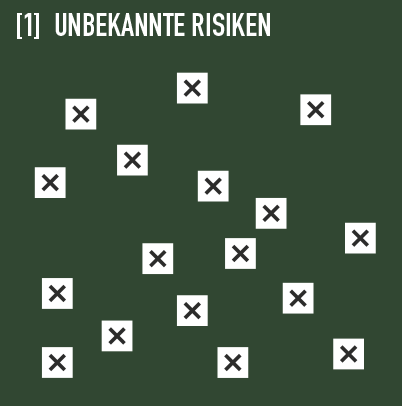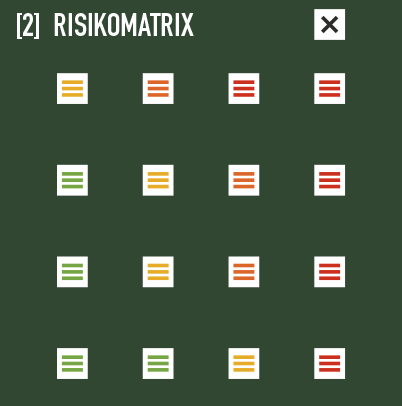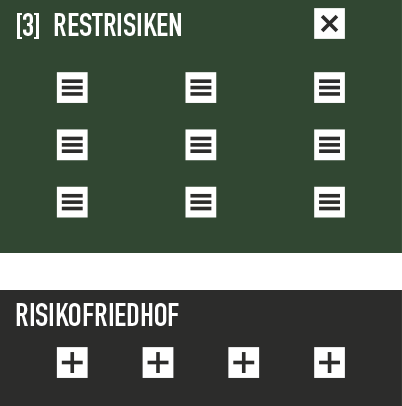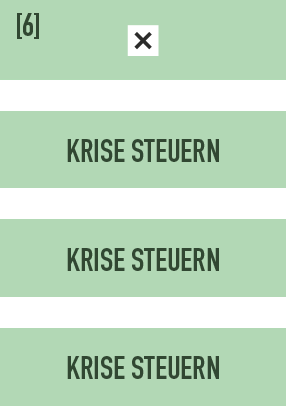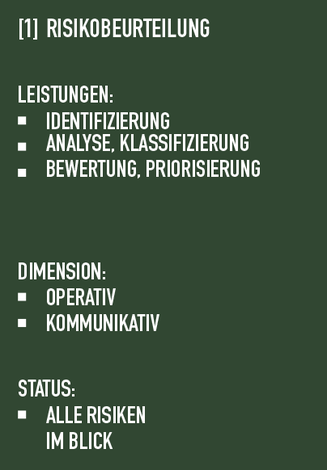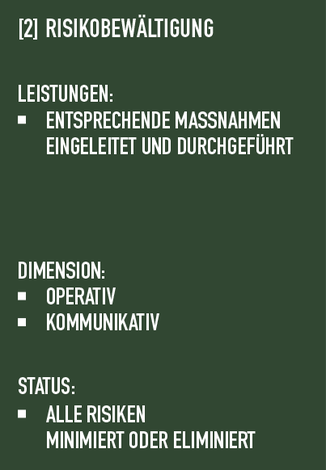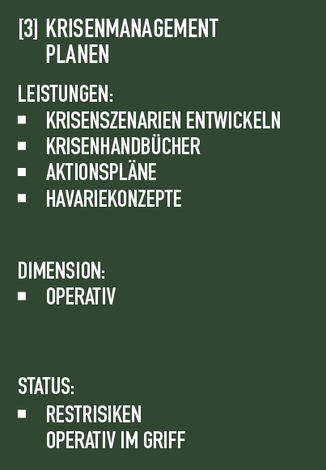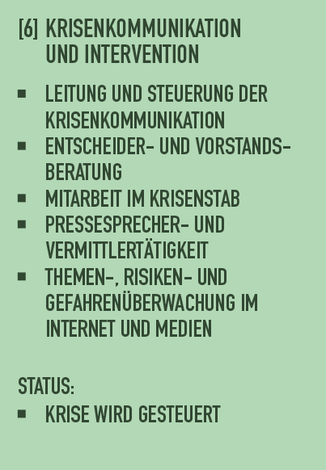Phase 1: Risk Assessment and handling
[1] Unknown Risks
Every company holds some dangers, so does yours. Better to know these risks well. If you do, you will have a greater chance to accomplish your business objectives safely and successfully.
[2] Risk Matrix
All risks are identified, analysed and assessed systematically. The greatest risks have to be tackled first.
[3] Remaining Risks
After our risk assessment and the implementation of corresponding measures, a manageable number of minimised risks remains. This advantage needs to be used for thorough preparation.
Phase 2: Sensitive Crisis Prevention
[4] Remaining Risks
Now it is time to target each remaining risk separately.
[5] We develop customised crisis management and crisis communication for every single crisis scenario.
That means: planning strategies, composing arguments and messages, training for interviews, press conferences and cross-examinations, and rehearsing procedures.
[6] In case of an actual crisis the situation is managed confidently.
Even if an unexpected risk occurs, you have a crisis management and communication procedure at your disposal.
[K.II.]
The 6 Steps of Sensitive Crisis Prevention
[1] Risk Assessment
- preparation: We create a briefing paper targeted to your company and questionnaires for every division of the company.
- one-on-one appointments with the executive board, management, corporate communications
- interviews and workshops
- risk assessment: the entire risk for the company’s reputation, taking into account all communicative and operational aspects
- the result: awareness of all risks
[2] Risk Handling
- We present the results of our analysis and our recommendations to the executive board.
- risk handling: introduce and execute necessary corrections
- Gloria Mundi helps you and everyone in charge to implement our recommendations.
- the result: minimisation or elimination of all relevant risks
[3] Crisis Management Planning
- remaining risks: act out customised crisis scenarios
- compile crisis guidelines, plans of action and emergency concepts
- the result: operational control over all remaining risks
[4] Crisis Communication Planning
- plan the corresponding crisis communication for every possible type of crisis
- decide on a strategy, compose arguments, prepare messages, keep files readily available and in systematic order
- templates for communication with a clean legal background
- strengthening all corporate capacities to communicate quickly, clearly and coherently in a crisis
- the result: communicative control over all remaining risks
[5] Crisis Training and Exercises
- media and speech trainings
- crisis simulations and emergency exercises
- You know what to say in case of a crisis even before it actually occurs. And you will speak with one voice
- regardless of who is communicating for your company.
[6] In Case of a Crisis: Crisis Communication and Intervention
- In an emergency, the crisis is managed confidently.
- You take the plans for this exact situation out of the drawer and know what to do instantly.
- daily adaptations with regard to current developments suffice.
- In addition, we stand by your side as trusted confederates, should you want that: for leading and managing the crisis communication, advising decision makers and board, as members of your crisis task force and in issue and threat monitoring.
[KP.III.]
Crisis Prevention: Our Approach
Making wise use of peacetime
Keeping risks under control, not just being aware of them
Keeping risks under control, not just being aware of them Being aware of your risks is one thing. Keeping them under control is something else entirely. The difference is decisive: The first one makes you risk-aware but can also keep you up at night. The second one makes you feel safe and your nights peaceful again. Especially when it matters: in case of an emergency.
Let us get to the point: in many companies and institutions the risk management approach does not go far enough. It simply is not satisfactory if risks are only pointed out or, at most, partly reduced. In case of a crisis you nevertheless remain unprepared: when critics are building up pressure, cameras are running outside the factory, worried citizens keep calling and so on. Which company can afford this?
Most managers and responsible decision makers want to know that their company is well prepared at all times. What they do not want is having to continuously worry about it.
Thorough preparation for emergencies
What most companies are missing is solid preparation for emergencies. We develop customised plans of action for every possible risk and crisis scenario, prepare the accompanying crisis communication, and practice the respective types of crises in trainings – using realistic simulations. Corporate perception cannot be frozen in defence and provision or perpetually trimmed for defensive and risk awareness – the so-called risk-based thinking. Being an entrepreneur means taking risks. The aim should therefore not be to keep risks or dangers small but to make your company great. Managers and anyone in charge want active and feasible safety.
[K.IV.]
Handling Risks is now Mandatory: ISO 9001:2015
ISO 9001 is a norm for quality management issued by the International Organization for Standardization (ISO). The revised version ISO 9001:2015 now explicitly demands a consideration of relevant risks from the certified companies. That means, from 2017 onwards, appropriate measures for risk assessment and handling need to be demonstrated in order to obtain the ISO-certification. The requirements of the norm, however, are put vaguely. Depth and extent of the respective risk management systems in companies vary accordingly. It is the board’s decision how much they want to invest in this requirement and, as a result, how effective such a system can actually be.
Risk management is seen as indispensable for companies today – whether ISO-certified or not. Even if risk management is effectively only a first step. If your company does not yet have any risk management, our crisis prevention starts with risk assessment. But if risk management has already been established – for example because of an existing ISO-certification – we aim for close cooperation with your present risk management and build our preparations upon that.
Invest with maximum use
The topic evidently is becoming more important every day. The risk management requirements in the latest ISO revision reflect this development. Invest in a way that allows your company to make the most of it: being prepared in an emergency. As experts for crisis management and communication, we make sure you have a firm grasp of it too. Together with you, we tackle your risks decisively and skilfully. Make use of our sensitive crisis prevention; you will be able to sleep even better. In times of peace, we provide you with a reliable and effective emergency preparation. With us, you will have secured your first ally.
[KP.V.]
Guide to Sensitive Crisis Prevention
No company can afford to be unprepared in an emergency. Therefore, prepare for these exceptional circumstances during times of peace and recognise where and how your offer or product is at risk and what you can do about it. We have described how to do this in a guide to crisis prevention.
